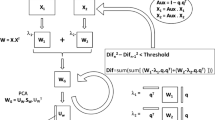Abstract
Principal component analysis (PCA) is the most commonly used chemometric technique. It is an unsupervised pattern recognition technique. PCA has found applications in chemistry, biology, medicine and economics. The present work attempts to understand how PCA work and how can we interpret its results.
Similar content being viewed by others
Suggested Reading
D L Massart, B G M Vandeginste, L M C Buydens, S de Jong, P J Lewi and V J S Verbeke, Handbook of Chemometrics and Qualimetrics, Elsevier, New York, 1997.
R Kramer, Chemometric Techniques for Quantitative Analysis, Marcel Dekker, New York, 1998.
H P Singh, R K Gulati and Ranjan Gupta, Stellar Spectral Classification Using Principal Component Analysis and Artificial Neural Networks, Monthly Notices of the Royal Astronomical Society, Vol.295, pp.312–318, 1998.
K Kumar, P Bairi, K Ghosh, K K Mishra and A K Mishra, Classification of Aqueous-based Ayurvedic Preparations Using Synchronous Fluorescence Spectroscopy and Chemometric Techniques, Current Science, Vol.107, No.3, p.107, 470–477, 2014.
K Kumar, S Sivabalan, S Ganesan, and A K Mishra, Discrimination of Oral Submucous Fibrosis (OSF) Affected Oral Tissues From Healthy Oral Tissues Using Multivariate Analysis of In-vivo Fluorescence Spectroscopic Data: A Simple and Fast Procedure for OSF Diagnosis, Analytical Methods, Vol.5, pp.3482–3489, 2013.
B R Kowalski, T F Schatzki and F H Stross, Classification of Archaeological Artifacts by Applying Pattern Recognition to Trace Element Data, Analytical Chemistry, Vol.44, pp.2176–2180, 1972.
T Kowalkowski, R Zbytniewski, J Szpejna and B Buszewski, Application of Chemometrics in River Water Classification, Water Research, Vol.40, pp.744–752, 2006.
M F Harkat, G Mourot and J Ragot, An Improved PCA Scheme for Sensor FDI: Application to An Air Quality Monitoring Network, Journal of Process Control, Vol.16, pp.625–634, 2006.
S Wold, K Esbensen and P Geladi, Principal Component Analysis, Chemometrics and Intelligent Laboratory Systems, Vol.2, pp.37–52, 1987.
de la P Mata-Espinosa, J M Bosque-Sendra, R Bro and L Cuadros-Rodriguez, Olive Oil Quantification of Edible Vegetable Oil Blends Using Triacylglycerols Chromatographic Fingerprints and Chemometric Tools, Talanta, Vol.85, pp.177–182, 2011.
http://www.models.life.ku.dk/oliveoil
S Balakrishnama and A Ganapathiraju, Linear Discriminant Analysis A Brief Tutorial, Institute for Signal and Information Processing, March 2, 1998. https://www.isip.piconepress.com/publications/reports/1998/isip/lda/lda_theory.pdf
S Wold, Pattern Recognition by Means of Disjoint principal component models, Patt. Recog., Vol.8, pp.127–139, 1976.
R Brereton, Chemometrics for Pattern Recognition, John Wiley & Sons, Ltd, U.K., 2009.
Author information
Authors and Affiliations
Corresponding author
Additional information
Keshav Kumar did his PhD from Department of Chemistry, Indian Institute of Technology-Madras, India, under the guidance of Professor A K Mishra. Currently he is working as a Postdoc at the Institute for Wine Analysis and Beverage Research, Hochschule Geisenheim University, Germany. His research mainly focus on chemometrics and its application in various fields.
Rights and permissions
About this article
Cite this article
Kumar, K. Principal component analysis: Most favourite tool in chemometrics. Reson 22, 747–759 (2017). https://doi.org/10.1007/s12045-017-0523-9
Published:
Issue Date:
DOI: https://doi.org/10.1007/s12045-017-0523-9




